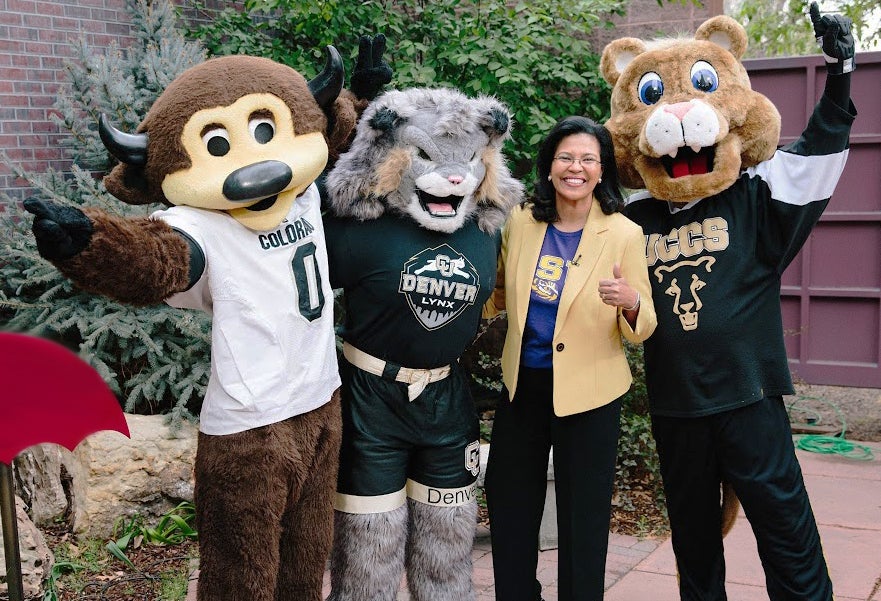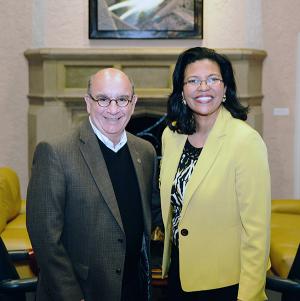Five questions for Kim Hunter Reed
The new executive director of the Colorado Department of Higher Education, Kim Hunter Reed, Ph.D., wore the purple-and-gold garb of Louisiana State University for last month’s College Friday. Naturally, a piece of her heart remains in her native state, where she earned three degrees (two from LSU) and worked as a higher education official.
Her mind, though, is clearly focused on her new home state.
“I’m certainly enjoying the opportunity to serve in this role,” said Reed, who most recently served in President Obama’s administration as deputy undersecretary at the U.S. Department of Education. Since arriving in Colorado in February, she has visited about a dozen campuses, including CU Boulder, with plans to visit more.
“Colorado is a fascinating place to be. I love the entrepreneurial spirit. People really believe they can make a difference and they try.”
A voracious reader, Reed quickly discovered Denver’s famed Tattered Cover bookstore. Her 15-year-old daughter’s volleyball tournaments keep Reed and her husband traveling on many weekends so they can cheer from the stands.
“On weekends when I’m here, I try to meet someone new and learn something new.”
1.You most recently worked on federal education policy in Washington, D.C. How do the two jobs compare?
The scale is different – national compared to state. But the scope of the work is very much the same. I do think both jobs have given me an opportunity to focus on the things I’m passionate about. In both positions I’ve worked on equity and excellence and how to expand opportunity for students.
I’m from a family of educators and I like to stay in the family business. My experience at LSU was a great one, and I want every student to have an outstanding college experience as well. I know that I was fortunate in two ways: one, college was an expectation in my home and two, I had the means to get there. Not every student has that. That’s why every day I’m passionately advocating for access and affordability for students. Our students and our institutions need more champions. We need to remind people that education is a common good.
People ask why I chose Colorado. It’s because you are working on things I’m passionate about that are challenging and rewarding. I’m honored to have this opportunity and I’m looking forward every day to advancing the ball and making a difference for our state and our citizens. I’m very excited about this work.
2.Though you’re still new on the job, you already have a strong presence on social media. What do you see as potential benefits for using these platforms for higher education in Colorado?
In a previous job, I was one of two employees who was not on Twitter. I got a call-out – “I really wish you would please use.”
I think social media has the power to amplify good policy information. I try to do something every day to make sure people are aware of the work we’re doing and to elevate the great institutions here in Colorado. It’s a way to promote their value.
As I travel around the state, I have had campus leaders and students say they’ve seen us at other campuses on social media. We’re getting a little bit of attention and I hope we get more. I certainly see it as an asset in our work.
3.How do you define the role of the University of Colorado in the state?
It’s a critical leader, obviously, and a leading innovator as well. Research there is extremely important, from space missions to medical research. But there’s also applied research for undergraduate students, which gives them hands-on experience.
My visit to CU Boulder was an amazing one. Chancellor DiStefano has a real vision and real commitment to the work. I’m looking forward to visiting the other CU campuses.
4.CU leadership has worked to keep tuition increases as low as possible, but state funding that ranks among the lowest in the country means college affordability continues to grow more challenging for many families. How can the trend be slowed or reversed?
I think we have to have a full-court-press approach of the state’s investment, community support, accelerated time to earning a degree, and early start for students. That full process will continue to help us.
But we have some real challenges. This is a state that has disinvested: We have seen a cost shift from the state investment covering two-thirds of the cost of tuition to the student’s share being two-thirds. We will not realize our real potential If we don’t have a sustained investment in higher education by the state. I’m looking forward to being part of that effort. We have to continue to talk about the public good that is higher education.
We’re happy to see in the state budget for 2017-18 that we have a $20.5 million increase for higher education, and we appreciate the governor’s and the Legislature’s support, which is very important.
From an agency perspective, there are a number of things we’re doing in terms of affordability. We have CollegeInvest, the 529 plan, and we need to get more people thinking about investing early. We’re raising scholarship dollars with COSI (Colorado Opportunity Scholarship Initiative); I already have met some folks who talked about how much COSI has made a difference.
Having students who are informed of choices is important as well. Concurrent enrollment, Supplemental Academic Instruction and other policies and practices can make the time to a degree faster and the cost of a degree cheaper. I’m proud to see that 30 percent of Colorado 11th and 12th graders, about 38,000 students, have earned college credit through dual enrollment.
Another number I saw two months ago is that only 57 percent of high school graduates are moving directly into college enrollment. We’d like to see more students participating. So we’re also thinking about stronger pathways, such as youth apprenticeship programs.
5.Our state ranks high in the number of adults with post-secondary degrees, but lower in terms of the percentage of high school students who go on to graduate from college. How can the “Colorado paradox” be addressed?
It’s a term I learned about when I arrived in the state. The idea of different geographic locations being brain magnets is not new to me. It is a positive that highly skilled, educated individuals would like to be part of the Colorado economy.
I’m more concerned that we have Colorado pride in our young talent. How do we invest in them? We have to double down on how to support our own talent. As you know, the knowledge economy has really reset the educational requirements for students in order to meet their full potential.
One of my goals is to make sure I honor every community by visiting. It’s impossible to sit in Denver and understand the challenges and opportunities happening across the state unless you walk the campuses with leaders, faculty, staff and students.
I also know it’s very important that we update our state master plan, which is well underway. The Colorado Commission on Higher Education is on track to vote in June. We need to reaffirm our commitment to having 66 percent of adults in the state with certificates and degrees.
A longer-term goal will be to make sure we have more champions of education – a broader coalition that’s supporting our work and informed of it. And we need to make sure we match our aspiration with the investment needed to reach our goals.
I’m honored to have the opportunity to work every day on those issues on behalf of the state and the students we’re serving.





